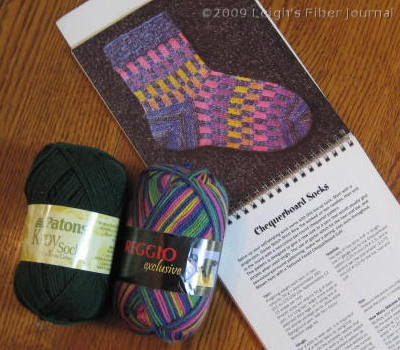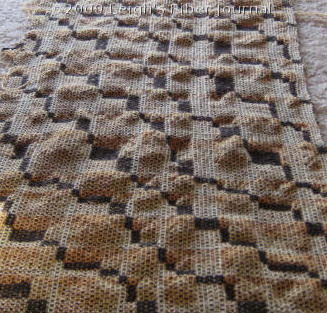By
LeighI decided I would start
this series the way I ordinarily would, by looking what I will need for the final product. In the next post, I will show you how I measure my handspun.
If you are a weaver, then you are already familiar with how to measure warp and weft for your projects. If you don't weave, then all of this may be quite foreign to you. My goal is to explain this so that non-weavers can get the gist of what goes into the process. I will try not to get too technical, but I may get long winded!
I've already mentioned that I have my eye on the
Folkwear Turkish Coat pattern for the
pol-paca I've been spinning. The obvious question is, how much yarn will I need to spin for this coat? As with any sewing project, the first thing I need to know how much fabric is required. Below is the information I found on the back of the package:
 Click on above for a better look-see.
Click on above for a better look-see.I have a 59 inch width loom, but only the first two measurements are possible for me. Why? Because of several factors that aren't apparent at first glance. Besides planning for finished fabric length and width, I also need to allow for loom waste, take-up, draw in, and shrinkage.
Loom waste - the part of the warp that is tied to the front and back of the loom and doesn't get woven. This can be anywhere from 18 to 36 inches depending upon one's loom.
Take-up - the result of the over and under path of the yarn as it is woven. Usually 10% is added to the project length to allow for this.
Draw-in - the pulling in of the selvedges during weaving. Usually 1 to 2 inches is allowed for this.
Shrinkage - From wet finishing (washing and drying) the fabric after it's off the loom. While this varies with the type of yarn, typically 10% is added. However, if the weaver is unsure, it is imperative that a sample is woven, washed, and dried!
Consider too, that the fabric is stretched tightly on the loom during weaving Simply cutting it off the loom causes it to relax and "shrink" somewhat. All these things must be accounted for when planning how much yarn will be needed for any project.
Let's say I plan to go with the second measurement, for a width of 45 inches, and length of 3 and 7/8 yards. I need to consider several things in order to plan the amount of yarn I will need. The formula I need to use looks like this:
Desired finished project length
+ fringe or hem (none here as it is yardage for sewing)
+ take-up (about 10%)
+ shrinkage (another 10%)
+ loom waste (I allow 24")
= total warp length.
I usually calculate in inches, and then convert to yards for measuring. Without boring you with all the math, I can tell you that to weave 3 and 7/8 yards of fabric, I will need a warp length of a tad over five yards. I will round this up to a minimum of 5.5 yards for the project.
What about weft? The formula for that is:
Desired finished width
+ draw-in (10%)
+ shrinkage (I'm allowing 2")
= total warp width
Taking all that into account, I need to plan on a width of about 52 inches on the loom, to end up with 45 inch wide fabric. If I wanted to weave the 54 inch fabric mentioned on the pattern, I would need to plan on a 62 inch width on the loom. With my loom only accommodating a 59 inch width, you can see why this isn't a possibility for me.
However, this doesn't tell me how many warp threads I'm going to need in order to put a 52 inch width of warp on my loom. For that, I need to decide how many threads per inch I want my fabric to be. Here are a few more terms to help explain that:
EPI -
Ends
Per
Inch, i.e. threads per inch
Sett (noun),
Set (verb) - referring to ends per inch.
Obviously, the more ends per inch, the thicker and heavier the fabric will be.
Calculating sett is a science in itself. I often use charts, such as
these. Or methods such as
these or
this. But for this example, I'm going to rely on experience, and choose a sett of 8 epi. This is based on my working similar size acrylic knitting yarns for
twill afghans. I will weave a sample before actually warping for the pol-paca cloth, and this will let me know if adjustments need to be made. If the sample is too thick or too heavy for a coat, I will try a lower sett. If it isn't thick enough, I will increase the sett.
Armed with that number (8 epi), I can figure out how many warp ends I will need.
52 inch width on loom
x 8 epi
= 416 ends
Multiply this by the 5.5 yard length I need to warp, and I come up with a total of 2288 yards of handspun required for the warp.
And for the weft? First, a few more terms:
Pick - term for individual weft threads
Shot - same as pick
PPI -
Picks
Per
Inch
If I plan to make a "balanced" cloth, i.e. with as many weft
picks
per
inch as warp
ends
per
inch, then I will use 8 (the EPI), to multiply by the number of inches in 3 and 7/8 yards.
52 inch width on loom
x 8 PPI
x 140 inches in 3 and 7/8 yards
= 58,240 inches, which rounds up to 1618 yards needed for the weft
Assuming I've calculated correctly then, I will need approximately 3906 yards of handspun yarn to weave the fabric for this coat. Plus a little more for the sampling.
So, how much handspun do I have so far? We'll look at that next time.
Posted 23 April 2009 at
http://leighsfiberjournal.blogspot.comRelated Posts:
Spinning For Weaving, Knitting, Crochet, Etc. An IntroductionCalculating SettAnother Way to Calculate Sett
 After wet finishing .....
After wet finishing ..... Both yarns shrank the same! My experiment was a flop.
Both yarns shrank the same! My experiment was a flop.
















